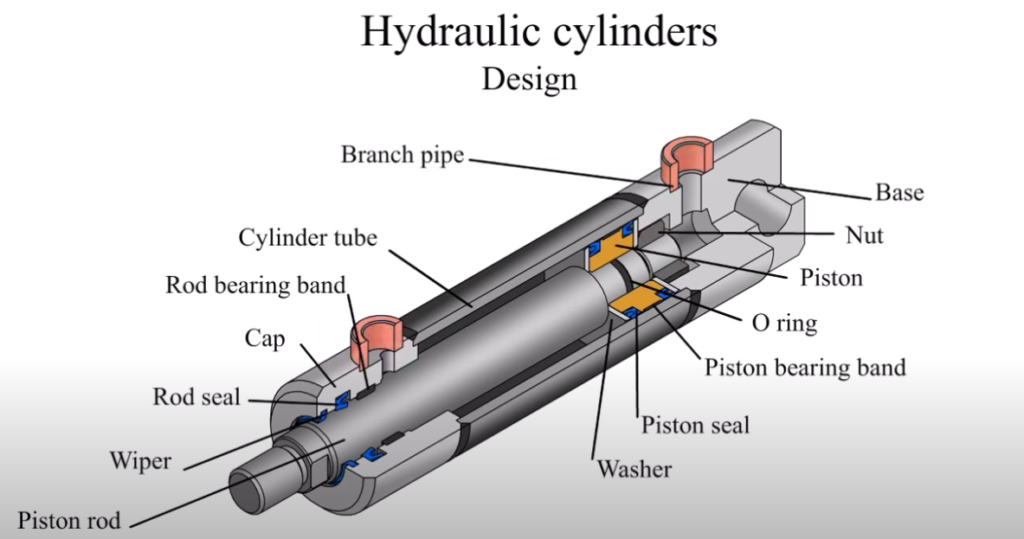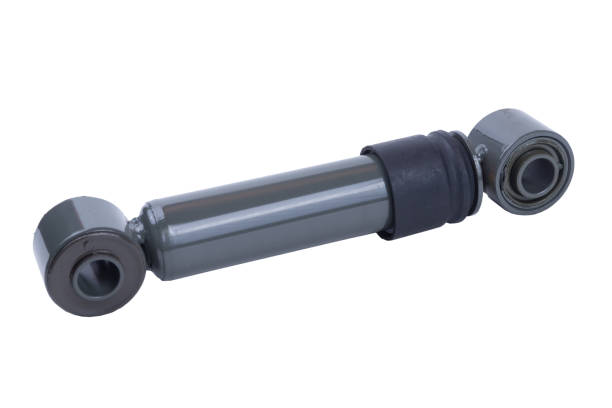Last Updated on October 23, 2024 by Čens
Hydraulic cylinders are essential components in a wide range of machinery, converting the energy from pressurized fluid into precise linear motion. For those working with Metāla polimēru bukse, it is important to understand the key parts of a cylinder to ensure proper operation and maintenance. This guide will outline the major components and highlight the importance of maintaining the correct pressure within the hydraulic system to ensure optimal performance.

Cylinder Barrel
The cylinder barrel serves as the core structure of a hydraulic cylinder, usually crafted from seamless thick-walled forged pipe or honed tubing. Its key functions include:
- Containment: The barrel encloses the piston and hydraulic fluid, effectively maintaining the necessary pressure for optimal operation, preventing leaks and ensuring efficient performance.
- Durability: Engineered to endure high pressures and resist wear, the barrel is built to provide long-term reliability and withstand the stresses of hydraulic operation, thus reducing the frequency of replacements.
- Smooth Operation: The internal surface of the barrel is precisely machined to achieve a smooth finish, facilitating the unrestricted movement of the piston. This design minimizes friction, enhances efficiency, and contributes to the overall effectiveness of the hydraulic system.
Piston
The piston is a crucial cylindrical component within the hydraulic cylinder, serving to divide the cylinder barrel into two distinct chambers. Its primary functions include:
- Pressure Separation: The piston creates two separate pressure zones within the barrel: the cap end and the rod end. This division allows for controlled movement and effective force application in both directions.
- Force Generation: When hydraulic fluid is pressurized, it exerts force on the piston. This force causes the piston to move, generating linear motion that drives the attached mechanism or load, such as a hydraulic arm or press.
- Sealing: The piston is fitted with seals, such as O-rings or U-cups, which play a critical role in preventing fluid leakage between the chambers. These seals ensure efficient operation by maintaining pressure and preventing contamination of the hydraulic fluid. Proper sealing is essential for the longevity and reliability of the hydraulic system.
Piston Rod
The piston rod is a critical component of the hydraulic cylinder that connects the piston to external machinery. Its main functions include:
- Force Transmission: The piston rod transfers the mechanical force generated by the piston to the external load or machinery being moved. This force enables the hydraulic system to perform tasks such as lifting, pushing, or pulling.
- Guidance: The rod ensures the piston moves in a controlled, linear motion within the cylinder barrel. Its rigidity and alignment are key to maintaining smooth and precise operation.
- Sealing Mechanism: As the rod passes through the cylinder head, it is equipped with seals that prevent hydraulic fluid from leaking out of the cylinder. This sealing system is essential to maintaining pressure within the cylinder and ensuring efficient, leak-free operation. Proper sealing of the piston rod also helps to protect the system from external contaminants.

Cylinder Head (Gland)
The cylinder head, also referred to as the gland or blind end, encloses one end of the hydraulic cylinder. Its key functions include:
- Pressure Containment: The cylinder head seals off one end of the barrel, ensuring that the internal pressure is maintained. This pressure containment is crucial for the effective operation of the hydraulic system, allowing fluid to exert force on the piston without escaping.
- Seal Arrangement: The cylinder head contains seals designed to prevent hydraulic fluid from leaking around the piston rod as it moves in and out of the cylinder. These seals are critical for maintaining system efficiency, preventing contamination, and ensuring the long-term reliability of the hydraulic cylinder.
- Mounting Options: The cylinder head often includes features or attachments for mounting the hydraulic cylinder to other structures or machinery. These mounting options enable the cylinder to be securely fixed in place, ensuring proper alignment and functionality during operation.
Bushings
Bushings are integral components within hydraulic cylinders, serving to reduce friction between moving parts, such as the piston rod and the cylinder wall. Their main function is to provide a low-friction interface that enhances both durability and efficiency of the system.
Functions:
- Friction Reduction: By minimizing friction, Uzmavas gultnis ir modificēta caurule vai caurule, kuras iekšējā virsma ir apstrādāta līdz vārpstas pareizajam diametram help facilitate smoother movement of the piston rod, reducing wear and tear on both the rod and the cylinder wall, which prolongs the lifespan of the hydraulic cylinder.
Types:
- Plain Bushings: These are simple cylindrical sleeves that provide basic support and alignment for the piston rod. They are effective for general applications where lubrication is managed externally.
- Self-Lubricating Bushings: These bushings are made from composite materials designed to reduce wear while eliminating the need for additional lubrication. Typically constructed from layers of materials like steel, copper powder, and a plastic layer, they offer enhanced wear resistance and efficiency, making them ideal for applications with limited maintenance access.
Looking for high-performance bushings to enhance the efficiency and longevity of your hydraulic systems? Contact us today to explore our range of precision-engineered Uzmavas gultnis ir modificēta caurule vai caurule, kuras iekšējā virsma ir apstrādāta līdz vārpstas pareizajam diametram, including self-lubricating options designed to reduce friction, minimize wear, and keep your equipment running smoothly. Don’t wait—optimize your machinery’s performance and reduce maintenance downtime with our durable and reliable bushing solutions. Get in touch with our experts now for a free consultation!

